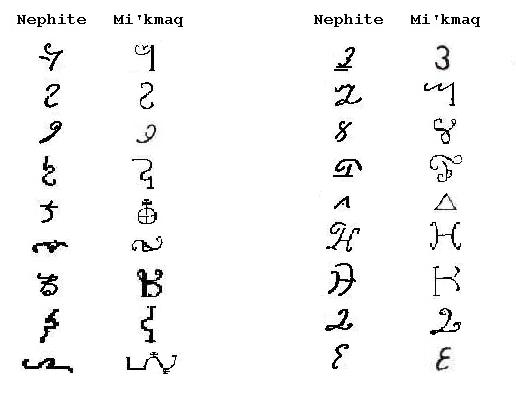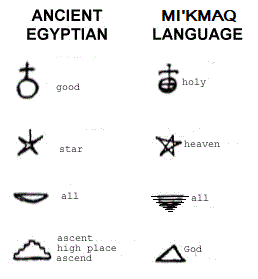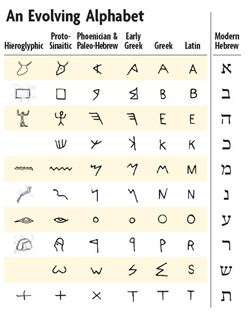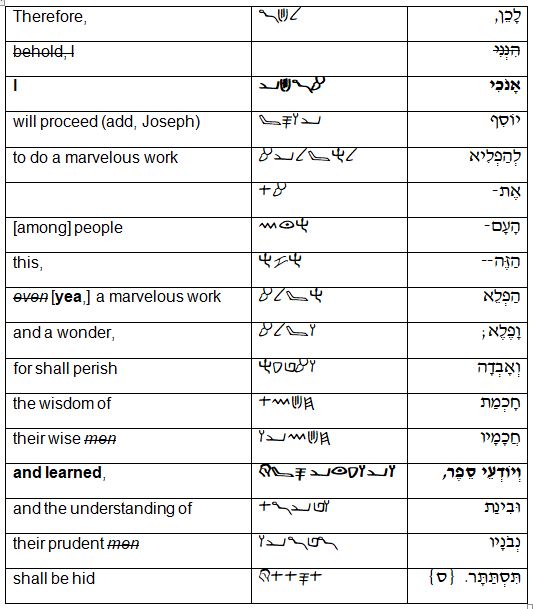|
A translation accompanied some
Book of Mormon characters that
the Prophet
Joseph Smith had "drawn
off the plates". According to
Joseph Smith's associate Martin Harris, these characters, "with
the translation thereof" were shown to Professor
Charles Anthon, and to Dr.
Samuel L. Mitchell of NY. Dr. Mitchell sanctioned what Professor
Anthon had allegedly said about the translation of the
characters, "that
the translation was correct, more so than any he had before seen translated
from the Egyptian."
(Joseph
Smith - History 1:62-65)
Yes, it's possible that Professor Anthon and Dr. Mitchell were familiar with
some ancient Egyptian symbols. But even if they could read some Egyptian
(in all likelihood they could not) it is doubtful that they would have been able to
read the highly compressed "reformed Egyptian" writing (more compressed than
Hebrew,
Mormon 9:32-33) found on the
Book of Mormon plates.
The Book of Mormon prophet Moroni explains, "… the Lord knoweth
the things which we have written, and also that none other people knoweth
our language [writing]; and because that none other people knoweth our
language [writing], therefore he hath prepared means for the interpretation
thereof." (Mormon 9:34)
Jewish scripture distinguishes between "language" or "tongue" which is spoken, and
"writing" or "script" which is written.
(Esther 8:8-9)
When Jewish scripture is translated into English, however, the terms "language" or
"tongue" are sometimes inserted in the translation for the sake of explanation, even though the
Hebraic terms for "language" or
"tongue" may not actually be present in the ancient text.
For example, compare
Isaiah 36:11 (KJV)
with Hebrew Yesha'Yahu 36:11. Also compare
Ezra 4:7 (KJV)
with Hebrew/Aramaic Ezra 4:7. In
Ezra 4:7 (KJV) the word "tongue" (i.e. language) is
used in describing a written language, or script. The word "tongue" or "language"
isn't actually present in the ancient text. What is translated
"Syrian language", or "Syrian tongue" is literally
"Aramit" (ארמית),
or Aramaic. What is translated "Jews' language", is really "Yehudit"
(יהודית), Judean, Jewish,
or Hebrew.
Similarly, the appearance of the word "language", in 1 Nephi 1:2-3,
Mosiah 1:4;
24:4-6
and Mormon 9:34,
where writing is being discussed, may not have explicitly appeared on the
Book of Mormon plates.
Neither Professor Anthon, nor Dr. Mitchell had the divine means (mentioned in Mormon
9:34 above) for translating Nephite writing. So, how
could these learned gentlemen have confirmed, or sanctioned a translation of
Book of Mormon characters?
Perhaps the "reformed Egyptian" characters copied from the
Book of Mormon plates were of two types:
(1) A set of characters for communicating the narrative
logogrammatically (symbols representing entire words or ideas), and
(2) another set of Egyptian like symbols for
phonetically communicating certain portions, e.g. names and quotes from Jewish
Scripture. These reformed, phonetic "Egyptian" characters would be equivalent
to letters spelling out words in ancient Hebrew (e.g.
Yehudit,
Isaiah 36:13).
Consider the introductory statement of Nephi son of Lehi:
"…I make a record in the language [writing,
words] of my father, which consists of the
learning of the Jews [Yehudit]
and the language of the Egyptians [Mitsrit]."
(1
Nephi 1:2)
Times & Seasons is an example of phonetically spelling out words
using letters, and including a logogrammatic symbol (&) to represent an entire
word - and.
An example of a logogrammatic writing system which has been compared to Egyptian,
is Native North American
Mi'kmaq (Micmac).
"Reformed
Egyptian"
characters copied from the Book of
Mormon
plates resemble
Mi'kmaw logogrammatic writing:

A Reliable Nephite, Mi'kmaq Comparison (Above) resources an
early Mormon document featuring characters said to
have been copied from the Book of Mormon
plates. These are compared to characters from MI'KMAQ HIEROGLYPHIC PRAYERS – READINGS IN NORTH AMERICA'S FIRST INDIGENOUS SCRIPT, edited and translated by David L. Schmidt and Murdena Marshall (1995, 2006).
Beware Mark
Hofmann's Anthon Transcript Forgery!

Egyptian - Mi'kmaq Comparison, following the work of
Barry
Fell
An example of a phonetic alphabet (really aleph-bet)
featuring Egyptian like symbols, is seen in
ancient Proto-Sinaitic script. These "reformed Egyptian" characters
were used to write ancient Hebrew.
The Nephite plates of
nehoshet (copper alloy like bronze,
translated "brass",
KJV), which contained the Hebrew
Torah, and prophetic writings, were likely written,
at least in part, in a form of phonetic "Egyptian",
perhaps like Proto-Sinaitic script. (Mosiah
1:3-4) According to the Book of Mormon, these plates were kept by descendents of Yoseph
(Joseph of Egypt) who chose to live at Jerusalem, and mingle with the descendents of
Yehudah (Judah,
1 Chronicles 9:3,
2 Chronicles 30:1,
10-12).
The plates of nehoshet may have also included
examples of Jewish writings, written with an iron pen (Jeremiah
17:1) in Phoenician like letters. This pre-exilic Hebrew writing
was common in the day of YirmeYahu (Jeremiah) and
Lehi (Lehi, a Hebrew word and name). (1
Nephi 5:10-13) An example of this type of writing appears on the
Tennessee Mound Tablet.

Spoken Nephite was likely a form of Yehudit, "the learning of the Jews". The
Josephite Nephites considered themselves "Jews" even before they
intermingled with the Jewish Mulekites. (2
Nephi 30:4;
33:8-9)
The Nephites, according to scripture, had one evolving, assimilating spoken
language (like Hebrew, which by the way contains Egyptian loanwords), and
more than one writing system. (Mormon
9:32-34,
Omni 1:17-18; Mulekite and Jaredite names were assimilated into
Nephite).
Nephite writing consisted of
(1) a unique system of writing using a highly compressed form
of reformed Mitsrit, called "reformed Egyptian", adapted to their singular Semitic language.
(2) Various alphabetical symbols, affording the Nephites more than one
way of phonetically spelling out Yehudit (Judean Hebrew).
Logogrammatic symbols allowed a great deal of narrative to be recorded using
less space on metal plates. (Mormon
9:33)
So, why not write everything on the plates using logogrammatic "reformed
Egyptian" characters? The answer is, that nuances of sacred, prophetic,
even poetic meaning could be lost when transcribing Yehudit into terse, highly compressed, logogrammatic symbols. (3
Nephi 5:18,
Ether 12:23-25,
40,
Jacob 4:1,
Jarom 1:14)
Thus we see that a phonetic system of writing was also needed. But why have more than one
way of phonetically writing Yehudit (Hebrew) on the plates? That is, why use
Egyptian like symbols as letters, or alternately, pre-exilic Phoenician
letters common in Lehi's day?
The answer may be that the Egyptian like pictorial hieroglyphs were not only
useful in spelling out words, they also graphically suggested
additional meanings,
that were obscured when Hebrew was written Phoenician like. The
Phoenician like letters, on the other hand, were easier to inscribe. But these characters, as also the phonetic Egyptian
like characters, took up more space than the logogrammatic "reformed Egyptian" writing.
To see additional meanings in picture characters, consider the sacred Tetragrammaton
displayed in the symbols of the Sinai alphabet. Or consider a word as simple as the first person personal pronoun "anokhi"
(אנכי).
Each Hebrew letter has hieroglyphic significance. To better see this, click on each of the following letters,
read right to left:
א
נ
כ
י.
In the Hebrew letter nun
(נ), for instance, one may see either a symbol for
a
sprouting seed, or a
serpent.
But how could the learned
Professor Anthon and Dr. Mitchell have seen enough in
a sample of "Egyptian" characters to validate its translation in
English? The answer may be hinted at in the Hebrew expression translated
"learned" in
Yesha'Yahu (Isaiah) 29:11. In this verse, "learned"
literally means "knowing a book" or "skilled in the book".
See also
Yesha'Yahu (Isaiah) 29:12.
Which book did Professor Anthon and Dr. Mitchell both have some skill in?
The Bible of course, at the very least! The honorable professor and doctor did not
possess divine "Lights and Perfections" (Urim
v'Tummim)
with which to read the "Egyptian" characters. But being men of letters,
interested in ancient languages, they both had access to the Hebrew
Bible.
It's possible that the translation handed to these learned men by
Martin Harris, was familiar to them! It may have been recognized
as a quote from Isaiah. For all we know, the
116 lost pages of Book of Mormon manuscript included some quotes from Isaiah, characteristic of other
books in the Book of Mormon.
In fact, some quotes, or expressions found in Isaiah are repeated in the Book of Mormon.
1
Nephi 14:7,
21:22; 22:8,
2 Nephi 6:5-6;
27:26 to cite a few.
Though not immediately readable, the
symbols that went along with the English translation may have clearly
resembled Egyptian. All that was left to do was to look up the text in the
Hebrew Bible, and to compare the Hebrew words and letters to the "Egyptian" characters. The
learned
also could have compared the English translation to the KJV.
Seeing such strong, consistent correspondence between the placement of the
"Egyptian" characters and the Hebrew letters, a learned person like Dr.
Mitchell could
have justifiably pronounced the translation in English "correct, more so
than any … before seen …"; this in light of the fact that the provided English translation omitted the italicized filler words present in the King James
translation.
2 Nephi 27:26 (similar to
Isaiah 29:14) is given below as a plausible example of a
translated text like the one Joseph Smith may have given to Martin Harris to show
to the learned. The prophet's text accompanied the sample of characters from which it
was translated. Along with these translated "Egyptian" characters,
Martin Harris could have presented a sample of logogrammatic characters,
similar to the above,
which were not accompanied with a translation.
Here is the sample of phonetic "Egyptian" characters (possibly similar to
those on the plates) accompanying Joseph Smith's translation:

The words in bold do not appear in the
Masoretic Hebrew Text version of this verse. (Isaiah
29:14) The King James Old Testament
was translated from the Masoretic Text.
For comparison, see the sister verse as it appears in the King James
Bible below, followed by the Hebrew text from which it was translated:
"Therefore, behold, I will proceed to do a marvelous work among this people, even a marvellous work and a wonder: for the wisdom of their wise
men shall perish, and the understanding of their prudent men
shall be hid." (Isaiah
29:14, KJV)
לכן הנני יוסף להפליא את העם הזה הפלא ופלא ואבדה חכמת חכמיו ובינת נבניו תסתתר
Here is the same verse written in Phoenician like letters similar to those
used in Lehi's day:

Next, in columns, is a side by side comparison between the "Egyptian"
looking characters (middle) and the biblical Hebrew (right) that corresponds to the English
translation of the Book of Mormon verse (repeated in 2
Nephi 27:26). This table facilitates the kind of comparison and
correlation that could have been performed by a learned gentleman
familiar with the Bible in Joseph Smith's day:

You don't have to know right away what the Egyptian symbols mean! You
just have to compare them to the words from the biblical text (noting their
correlation with the Hebrew letters). You may notice, for instance, that there is a single
hieroglyph like the Egyptian
water ripple (N35)
 that corresponds to two forms of the modern Hebrew letter mem
(מ,ם). that corresponds to two forms of the modern Hebrew letter mem
(מ,ם).
You may wonder about the "אֶת־" in the above verse. It can be thought of as the preposition "among".
But
אֶת in many cases represents an untranslatable direct object indicator.
Notice the crossed out italicized words in the
translation.
It becomes apparent that the English
translation is not only good, it's arguably better than the KJV,
because it leaves out italicized filler words that are not really
in the Hebrew text.
Also, in the text above, is an example of a possibly prophetic reference to
"Joseph"
(יוסף),
as God's instrument in bringing forth his "marvelous work and a wonder".
This is the kind of Hebraic double meaning that might be lost had this verse been reduced to logogrammatic symbols.
Martin Harris simply presumed that when the learned mentioned that the
characters were "Egyptian" that the translation was from the Egyptian
tongue. He was not correct in this presumption. But how was Martin to
know that it was possible to write a verse in
Hebrew using Egyptian like symbols?
As for the sample of characters (probably logogrammatic) copied from the
plates, that were presented to the learned without an accompanying translation, neither Professor
Anthon, nor Dr. Mitchell could read them. (Mormon 9:34)
Martin Harris visited with Dr. Mitchell before, as well as after Martin's
prophetic visit with the learned Charles Anthon. In fact, it could have been Dr.
Mitchell who first suggested that the set of "hieroglyphics" accompanying the
translation resembled Egyptian.
א
In 1831, James Gordon Bennett reported that "… Harris says that the Doctor received him very “purlitely,”
looked at his engravings--made a learned dissertation on them--compared them
with the hieroglyphics discovered by Champollion in Egypt--and set them down
as the language of a people formerly in existence in the East, but now no
more."
ב
According to Anthon, Martin Harris presented
him with a note from Dr. Samuel L. Mitchell, of New York, requesting him
(Anthon) to decipher, if possible, a paper which the "farmer" would hand to
him.
Anthon described the scroll of characters presented to him by the "farmer"
as "disposed in columns, and had evidently been prepared by some person who
had before him at the time a book containing various alphabets, Greek and Hebrew letters, crosses and flourishes; Roman letters inverted and
placed sideways were arranged and placed in perpendicular columns, ... I
have frequently conversed with friends on the subject since the Mormon
excitement began, and well remember that the paper contained anything else
but Egyptian hieroglyphics."
Anthon's denial of seeing any Egyptian
hieroglyphics on the scroll is eyebrow arching, since some Egyptian hieroglyphs in fact look like "crosses".
See Gardiner Z9, Z10, Z11.
Professor Anthon's accounts of his encounter with the "simple-hearted
farmer", are, to put it kindly, contradictory. We can accept the farmer's
account as accurate as far as he correctly
understood what the learned men said regarding the characters and their translation.
(Joseph
Smith - History 1:63-65)
Footnotes:
א. Richard E.
Bennett, "Martin Harris and Three Wise Men", BYU Speeches
ב.
Leonard J. Arrington, "James Gordon Bennett's 1831 Report on “The Mormonites”", BYU Studies Quarterly
Acknowledgements:
Special thanks to Romolo Simonetti for finding Bennett's 1831 report on line,
and for starting a discussion which led to this article.
Special thanks to author Phyllis Carol Olive for her encouragement and support.
Vincent Coon
כּוּן
וִינְסֶנט
© Copyright 2021
|